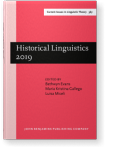Chapter 11
The diachronic development of postverbal dé
得 in Chinese
The modal dé
得 is one of the modal verbs of possibility in Late
Archaic Chinese (LAC) and Early Middle Chinese (EMC). Different from other modals verbs of possibility, which are confined to
preverbal position, dé
得 ‘obtain, get, manage to, can’ occurs in two
different positions in Modern Chinese and other Sinitic languages: preverbal and postverbal. This chapter argues that the two
different functions of de in modern Sinitic languages reflect two syntactic instantiations of de in LAC and
EMC. The preverbal modal auxiliary developed from the modal auxiliary verb dé ‘manage to, can’, which only
allows a vP complement, and the postverbal de developed from the lexical verb dé
‘get, obtain’, which allows a CP complement.
Article outline
- 1.Introduction
- 2.The diachronic development of DE from Late Archaic to Middle Chinese
- 2.1DE as a lexical verb
- 2.2DE as an auxiliary verb in LAC and EMC
- I.Ability reading
- II.Opportunity reading
- III.Implicative reading
- 2.3Deontic DE
- 3.The complement of DE
- 3.1DE with a vP complement
- 3.2DE with a CP complement
- 4.The development of postverbal DE
- 5.Conclusion
-
Notes
-
References
This content is being prepared for publication; it may be subject to changes.
References (34)
References
Aldridge, Edith. 2010. Clause-internal
Wh-movement in Archaic Chinese. Journal of East Asian
Linguistics 19(1). 1–36. 

Aldridge, Edith. 2012. PPs
and applicatives in Late Archaic Chinese. Studies in Chinese
Linguistics 33(3). 139–164.
Aldridge, Edith. 2013. Chinese
historical syntax: Middle Chinese. Language and Linguistics Compass: Historical
Linguistics 7(1). 39–57. 

Bhatt, Rajesh. 1999. Covert
modality in non-finite
contexts. Philadelphia: University of Pennsylvania dissertation.
Cao, Guangshun. 1999. Shilun hanyudongtai zhuci de xingcheng guocheng. [Study on the formation of aspectual particles in
Chinese]. In Alain Peyraube & Chaofen Sun (eds.), Studies
on Chinese historical syntax and morphology: Linguistic essays in honor of Mei
Tsu-lin, 19 32. Paris : École des Hautes Études en Sciences Sociales, Centre de Recherches Linguistiques sur l’Asie Orientale.
Cheng, Lisa Lai-Shen & Rint Sybesma. 2004. Postverbal
‘can’ in Cantonese (and Hakka) and Agree. Lingua 114. 419–446. 

Cormack, Annabel & Neill Smith. 2002. Modals
and negation in English. In Sjef Barbiers, Frits Beukema & Wim van der Wurff, (eds.), Modality and its
interaction with the verbal system, [Linguistik Aktuell 47 / Linguistics Today
47], 133–163. Amsterdam: John Benjamins. 

Feng Chuntian. 1992. “Zhuzi yulei” ‘de’, ‘le’, ‘zhe’ de zhuyao yongfa
fenxi. In Cheng Xiangqing (ed.), Song, Yuan, Ming Hanyu yanjiu. Shandong jiaoyu chubanshe.
Karttunen, Lauri. 1971. Implicative
verbs. Language 47(2). 340–358. 

Li Ming. 2001. Hanyu zhudongci de lishi
fazha. Beijing: Beijing Daxue dissertation.
Li, Yin. 2015. The
diachronic development of passive constructions from Archaic Chinese to Modern
Mandarin. Seattle, WA: University of Washington dissertation.
Lin, T.-H. Jonah. 2011. Finiteness of
clauses and raising of arguments in Mandarin
Chinese. Syntax 14(1). 48–73. 

Meisterernst, Barbara. 2008. Modal
verbs in Han period Chinese part I: The syntax and semantics of kĕ 可 and kĕ yĭ
可以. Cahiers de Linguistique Asie
Orientale, 37(1). 85–120. 

Meisterernst, Barbara. 2017. Modality
and aspect and the role of the subject in Late Archaic and Han period Chinese: Obligation and
necessity. Lingua
Sinica 3(10). 1–35. 

Meisterernst, Barbara. 2019. A
new approach on the modal KE 可 and the
relation between the aspectual and the modal system in Archaic
Chinese. In Barbara Meisterernst (ed.), New
perspectives on aspect and modality in Chinese historical linguistics [Frontiers in Chinese Linguistics
5], 159–189. Singapore/ Beijing: Springer & Peking University Press. 

Meisterernst, Barbara. 2020b. A
semantic analysis of modal DE 得 in
pre-modern Chinese. Lingua
Sinica 5(1). 1–29. 

Peyraube, Alain. 1999. The
modal auxiliaries of possibility in Classical
Chinese. In Tsao Fengfu, Wang Samuel ans Lien Chinfa (eds.), Selected
Papers from the Fifth International Conference on Chinese
Linguistics, 27–52. Taipei: The Crane Publishing Co. Ltd.
Pulleyblank, Edwin G. 1995. Outline
of Classical Chinese
Grammar. Vancouver: University of British Columbia.
Ramchand, Gillian Catriona. 2008. Verb meaning and the
lexicon: A first-phase
syntax. Cambridge: Cambridge University Press. 

Roberts, Ian & Anna Roussou. 2003. Syntactic
change: A minimalist approach to
grammaticalization. Cambridge: Cambridge University Press. 

Simpson, Andrew. 2001. Focus,
presupposition and light predicate raising in South-East Asian languages. Journal of
East Asian
Linguistics 10. 89–128. 

Sun Chaofen. 1996. Word-order
change and grammaticalization in the history of
Chinese. Stanford: Stanford University Press.
Tsai, Wei-Tian Dylan. 2015. On the topography of
Chinese modals. In Ur Shlonsky (ed.), Beyond
functional sequence, 275–294. New York, NY: Oxford University Press. 

Wang, Changsong. 2017. On
some mysteries, asymmetries and derivation of potential de construction in
Chinese. Language and
Linguistics, 18(4). 647–698.
Wang Li. 2004 [1980]. Hanyu shigao. Beijing: Zhonghua shuju.
Wei, Pei-Chuan. 2000. Xian Qin zhu wei jian de zhuci zhi de febu yu yanbian [The distribution and development of the nominalizer ZHI in the Pre-Qin period]. Zhongyang Yanjiu Yuan Lishi Yuyan Yanjiusuo Jikan [Academia
Sinica Bulletin of the National Research Institute of History and
Philology] 71 (3). 619–679.
Wei Pei-chuan. 2004. Jindai Hanyu nengxing dongbu jiegou zhong binyu de weizhi [Object position in verb-complement potential
constructions in early Mandarin]. Language and
Linguistics 5(3). 663–704.
Wu Fuxiang. 2004. Dunhuang bianwen 12 zhong yufa
yanjiu. Henan: Henan Daxue chubanshe.
Wu, Zoe Xui-Zhi. 2004. Grammaticalization and
language change in Chinese: A formal view. New York, NY/ Abingdon, Oxfordshire: Routledge. 

Wurmbrand, Susanne. 2012. Infinitives:
Restructuring and clause structure. Berlin: De Gruyter.
Xie, Zhiguo. 2012. The
modal uses of de and temporal shifting in Mandarin Chinese. Journal of
East Asian
Linguistics 21. 387–420. 

Xiong Jiajuan and Barbara Meisterernst. 2019. The
syntax and the semantics of the deontic modals yīng 應 and dāng 當 in Early Buddhist
texts. In Barbara Meisterernst (ed.), New
perspectives on aspect and modality in Chinese historical linguistics [Frontiers in Chinese
Linguistics
5], 191–220. Singapore/Beijing: Springer & Peking University Press. 

